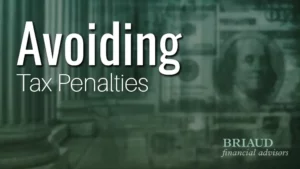As part of Briaud Financial Advisors’ comprehensive financial planning process, we spend a considerable amount of time reducing our clients’ tax liabilities. One cost that can be easily avoided is an “Underpayment Penalty.” This penalty arises when you underpay or underwithhold in a given tax year. The penalty is imposed on the amount you should have paid in federal taxes, and the interest rate changes quarterly. The current rates can be found here. In this post we will discuss ways to avoid this penalty in the future.

What is an ‘underpayment penalty’?
In the United States, our tax system works as a “pay-as-you-go” system, meaning that as you earn or receive income during the year, taxes must be paid on that income.
Potentially, if a taxpayer were to wait until the last minute to pay their taxes, or make a significant underpayment of their taxes, they will be hit with an underpayment penalty.
For most individuals, the tax payments are taken care of through their paycheck withholding, and no action is required. However, for those who have considerable outside income, other than their primary job, such as consulting, speaking, book royalties, business profits or investment income, they will need to take additional steps to avoid a penalty. These penalties can add several hundred dollars to your tax bill. We can help you maximize your off-campus and consulting income.
How can taxpayers avoid underpayment penalties?
There are several actions taxpayers can take to have the underpayment penalty waived:
- If you incur a penalty, you may request a waiver for one of the following reasons:
- Retirement after age 62
- You are disabled
- Had a reasonable cause for not making a payment (for example, a natural disaster)
- Taxpayer did not miss the payment intentionally
- If your tax liability is less than $1,000 after accounting for your paycheck withholding and estimated tax payments, then no penalty will be owed.
- If your tax payments over the tax year are greater than 90% of the amount you owe that year, then there will not be a tax penalty.
Some ways to avoid the underpayment penalty in the first place include:
- Make your estimated tax payments (if required) on time:
- They are due on the 15th of each of the following months: April, June, September, and January (of the next tax year).
- Communicate with your CPA if you expect any changes in your income throughout the year. Over communication is key for preventing underpayment penalties, plus, it gives your professional team (CPA & Financial Planner) time to do some high-level tax planning.
- If your tax payments equal 100% of the previous year’s tax liability for those whose adjusted gross income is less than $150k or 110% for those whose AGI is higher than $150k, then there will not be a tax penalty.
The IRS offers a tool that will guide you with your estimated tax payments. This tool can be found here.
Penalty-proofing
Our preferred method to avoid underpayment penalties is to have clients pay in 100% or 110% (depending on their adjusted gross income) of their previous year’s liability. This is known as “penalty-proofing.”
The advantage of this is you know exactly how much you need to withhold in order to avoid the underpayment penalty.
There is one major exception to our rule about penalty proofing: If a taxpayer is going from a high tax year to a low tax year, then we do not recommend penalty-proofing, as you will likely end up overpaying your tax liability and receive a large refund. In those situations, the best action is to work with a financial planner and/or a CPA to do a projection so you can pay the right amount of tax throughout the year.
Case Study
Professor Peggy, in addition to her work as a professor, is a highly regarded consultant in her field. Peggy received approximately $135,000 from consulting projects she did in the spring while she was on a sabbatical this year. Last year her tax liability was $20,000 and her adjusted gross income is expected to be greater than $150,000.
Because Peggy received income from her consulting income, with no taxes withheld, she should be making estimated quarterly payments to avoid an underpayment penalty. Because of the “pay-as-you-go” system, Peggy should send in a tax payment for the consulting income on the payment due date following the quarter during which the income was earned.
Another option, and our preferred method, would be to adjust her W-2 withholding so that enough taxes are withheld from her paycheck to make her penalty-proof. So, knowing that her previous year tax liability was $20,000, we would make sure $22,000 ($20,000 x 110%) is withheld over the tax year from her paycheck. Because Peggy’s withholding is 110% of her previous tax year’s liability, no underpayment penalty would be owed.
Another situation where we see underpayment penalties is with clients who have a large taxable portfolio (i.e., brokerage) with significant interest, dividends, or capital gains. If this is your situation, then you will want to work closely with a CPA and/or financial planner to plan properly.
We have yet to meet a client who wanted to pay more taxes. So, make sure that you are communicating with your CPA and financial planner about your income and you are taking steps to prevent unnecessary penalties. At Briaud, we are university retirement planning experts. If you are looking for ways to save taxes, then please reach out to us. We would be glad to share some ideas with you.
Editor’s note: This information is intended to be a guideline and should not be construed as tax advice. Most of the information contained in this post can be found on the IRS website. Consult your tax professional for advice specific to your situation.
